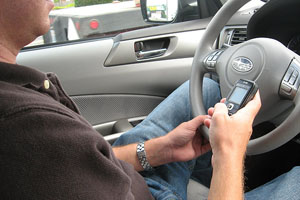 Over the past year, the national consensus about distracted driving has solidified as safety advocates, cell phone companies, and celebrities like Oprah Winfrey, agree that it is a dangerous practice that must be reduced. Most notably, Secretary of Transportation Ray LaHood has made the fight against distracted driving one of his signature goals. Regardless, a new study by a duo of economics professors has predicted that talking on the phone while driving could actually reduce car accidents. It’s an interesting headline-grabbing thought, but most likely wrong according to the science, statistics, and common sense.
Over the past year, the national consensus about distracted driving has solidified as safety advocates, cell phone companies, and celebrities like Oprah Winfrey, agree that it is a dangerous practice that must be reduced. Most notably, Secretary of Transportation Ray LaHood has made the fight against distracted driving one of his signature goals. Regardless, a new study by a duo of economics professors has predicted that talking on the phone while driving could actually reduce car accidents. It’s an interesting headline-grabbing thought, but most likely wrong according to the science, statistics, and common sense.
The new report is positioned as a response to a 2003 study by scientists from the University of Utah. “Just like you put yourself and other people at risk when you drive drunk, you put yourself and others at risk when you use a cell phone and drive,” wrote the report’s lead author David Strayer. “The level of impairment is very similar.” Since, a growing number of scientists have endorsed these findings, and last year, Car and Driver Magazine tested the theory, finding that attention and reaction time was worse for distracted drivers than drunk drivers.
The more recent distracted driving study cross-referenced cell phone call data with California accident statistics over an 11 day period in 2005. As call frequency increased, the report found, accidents decreased. “People who start talking while driving become more cautious,” the report states. “People who act like jackholes behind the wheel with a cell phone will act the same way without one. And although cell phones clearly distract some drivers, they may also help other drivers stay alert.”
Gawker’s Jalopnik blog writes that this data “should cause some reflection among the zealous anti-phone and driving types,” and proves that “what seems like common sense isn’t always sensical when it comes to auto safety, despite what Oprah might think.” But the blog TechDirt doesn’t completely buy it. First of all, notes Mike Masnick, the report focuses only on the minutes directly before and after 9 pm. “I wonder what a similar study would show closer to rush hour…If the roads are less congested, then the ‘danger’ is probably much lower,” he writes. “Also, just because a phone is moving, it doesn’t mean the person holding it is driving – they could be passengers.”
So before we rush to false conclusions about the conventional wisdom surrounding distracted driving, let’s wait for a more comprehensive scientific study of the practice. In the mean time, I’ll refer to Secretary LaHood’s harsh words for past critics of his campaign to curb distracted driving. “Regardless of what a powerful lobbying group has to say, the simple fact is that texting and talking on cell phones behind the wheel is a deadly epidemic,” he wrote on his blog. “To suggest otherwise is to put your head in the sand. To spend considerable resources to suggest otherwise is a glaring waste.”
See also: State-by-State Map of Distracted Driving Laws
Photo credit: mrJasonWeaver

